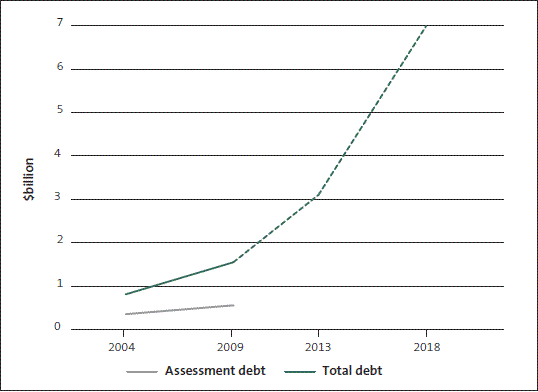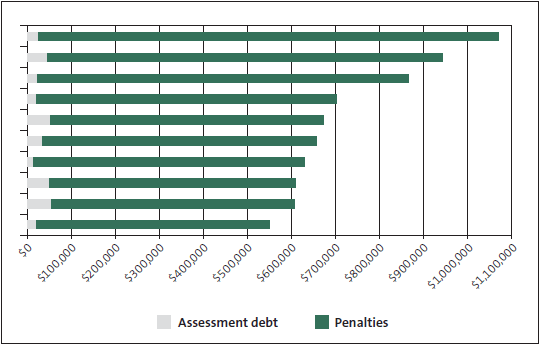Part 5: The penalty regime
5.1
In this Part, we set out our findings about Inland Revenue's penalty regime. We discuss:
- child support debt levels, composition, and growth;
- compounding penalties; and
- the likelihood of the penalty regime acting as a disincentive to voluntary payment.
5.2
We expected Inland Revenue to know:
- whether the penalty regime encourages parents to make child support payments; and
- whether the current penalty regime is efficient for Inland Revenue to administer.
5.3
Overall, we found there is a general belief among Inland Revenue staff that the current penalty regime can become a disincentive to make child support payments if a person's debt goes beyond a certain level. Inland Revenue has recently started some internal work reviewing penalties.
Child support debt levels, composition, and growth
Under the current penalty regime, it is projected that total child support debt could rise to $7 billion by 2018. Most of that debt will never be collected. Inland Revenue has few options for writing off child support debt.
5.4
In its 2009 annual report, Inland Revenue reported that, as at 30 June 2009, it has collected 88.6% of the $4.4 billion (excluding penalties) assessed by the child support scheme since the scheme began in 1992.
5.5
Total child support debt at 30 June 2009 was $1.56 billion (comprising $540 million of unpaid child support assessments, and $1.02 billion of unpaid penalties). These unpaid penalties are unlikely to ever be recovered; Inland Revenue's Annual Report 2009 recognises this by noting that impairment provisions against the penalty debt are more than 99%.
5.6
Because all penalties are paid to the Crown and some child support assessments are paid to the Crown in reimbursement of a benefit, about $195 million is owed to custodians, with the remainder owed to the Crown.
5.7
Figure 7 shows Inland Revenue projections for the growth of child support debt if current trends continue. It also shows the historical level of assessment debt. (Inland Revenue told us that it was unable to provide us with the assessment estimates from now until 2018.) These projections show child support debt growing to about $7 billion by 2018. Compounding penalties are responsible for most of this growth (the difference between the two lines represents the growth in penalties). Without any payments or additional child support assessments, a child support debt will double about every three years because of penalties.
Figure 7
Growth in child support debt 2004–2009, and projected growth to 2018

Source: Inland Revenue.
5.8
Under the Act, Inland Revenue has very few options for writing off a valid child support assessment, although it can write-off some penalties once a parent has started to pay the assessment debt. Because there are few write-off options available to Inland Revenue, it is extremely likely a case will continue accruing penalties until Inland Revenue can resolve the debt.
Compounding penalties
Compounding penalties mean that child support debts can become extremely large.
5.9
A child support debt can become very large if it is not resolved. Most of the debt will result from compounding penalties. Figure 8 shows the total outstanding balances, comprising the assessment and penalties, of the ten largest child support debt cases where the liable parent has never made a payment (as at March 2010). The last known location of all of the liable parents in Figure 8 was overseas, with one of the ten now believed (but not confirmed) to be deceased.
Figure 8
Ten largest child support debts where no payment has ever been made

Source: Inland Revenue
Penalties acting as a disincentive
Many of the Inland Revenue staff we spoke with felt that the current penalty regime reduces compliance. Inland Revenue has recently begun some internal work to review the penalty regime.
5.10
If a parent does not make their child support payments on time, they will incur additional debt in the form of penalties (discussed in Part 2). Penalties are meant to serve as a mechanism to support compliance.
5.11
In 2003, Inland Revenue produced a briefing paper for the Minister of Revenue about changing the write-off options for the child support penalty regime. The briefing paper stated:
For a significant percentage of the liable persons who are in arrears, their increasing penalty debt is acting as a disincentive to re-enter the child support system and begin payment of their ongoing child support liability.
5.12
The Child Support Amendment Act 2006 gave Inland Revenue greater discretion to write off penalties. Inland Revenue wrote off penalties totalling $26.8 million in 2007/08 and $21.7 million in 2008/09. Most of these penalties were written off because a portion or all of the outstanding assessment debt had been repaid. Even so, by the end of 2009, the total penalty debt outstanding was $1.02 billion (comprising $66 million of initial penalties and $950 million of incremental penalties).
5.13
Many of the Inland Revenue staff and managers we spoke with during our audit felt that the accumulated penalties could serve as a disincentive to comply.
5.14
We have not seen any research from Inland Revenue indicating that the child support penalty regime encourages parents to make child support payments.
5.15
In our view, the usefulness of penalties as an incentive is weakened by Inland Revenue speaking with only about 30-40% of liable parents when they enter the scheme, not providing all parents with information explaining the penalty regime, and not clearly setting out the penalties on regular statements.
5.16
Inland Revenue had started working on an internal paper about the penalty regime at the time of our audit. The paper was at an early stage, so we were unable to review its findings as part of our audit.
5.17
In our view, Inland Revenue needs to evaluate the current penalty regime and consider whether it is effective in promoting compliance. Staff comments about penalties and the very high level of impairment against this debt raise the question of how effective and efficient the current penalty regime is.
| Recommendation 4 |
|---|
| We recommend that the Inland Revenue Department assess whether the current child support penalty regime provides an impediment for parents to comply with child support obligations. |
5.18
Inland Revenue has told us it accepts this recommendation, and notes that its current review of child support penalties is internal and focuses primarily on the administration of the current penalty regime. Inland Revenue is continuing work on its internal review to improve the efficiency and effectiveness of policy and processes that support the current legislative framework.

